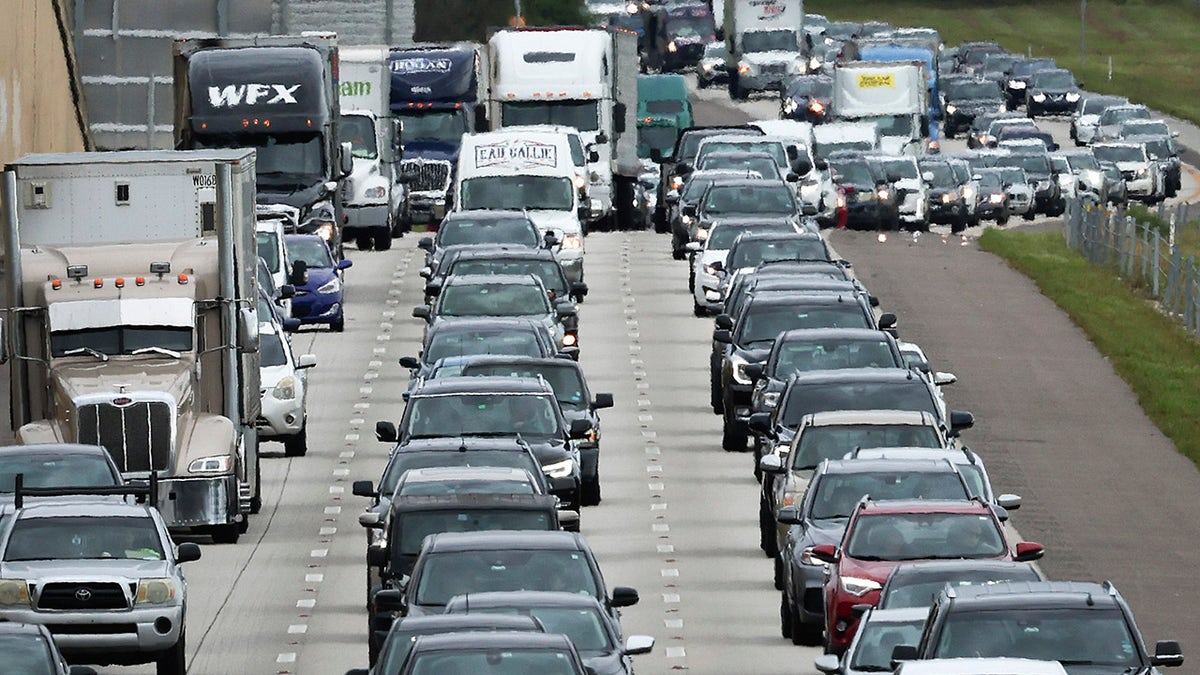Hurricane flooding can be deadly to drivers. Here's what to do if you get caught
Not everyone can evacuate before a storm hits
{{#rendered}} {{/rendered}}When hurricanes are heading for coastal areas, it is always advisable to evacuate long before they arrive.
You do not want to be on the road, let alone stuck in traffic when the storm hits, because flash floods can happen at any moment through heavy rain and surges.
Unfortunately, there are always some people who cannot get out in time, and areas serviced by bridges can be entirely cut off by authorities after a deadline has passed, forcing them to hunker down and ride out the storm.
{{#rendered}} {{/rendered}}When it passes, the floods may remain, making driving difficult for several days.
LIGHTNING STRIKES RAM PICKUP IN FLORIDA. HERE'S WHY THE PASSENGERS SURVIVED

Evacuating long before the storm arrives is the best option for coastal areas. (Win McNamee/Getty Images)
The National Weather Service's "Turn Around Don't Drown" campaign advises drivers to avoid going through standing water at all times, because there is no way to tell how deep it is, while flowing water just a foot-deep can carry a car away into obstacles or even deeper water.
{{#rendered}} {{/rendered}}Dozens of Americans lose their lives every year this way, but the chance of injury or death can be reduced if you know what to do when your vehicle gets caught in a flood.
Mike Berna, a regional director and instructor with the Rescue 3 International group that provides training to emergency services, shared several simple survival steps with Fox News Digital that drivers should keep in mind when they find themselves in a flooded area.
Safety experts say it is always inadvisable to drive through water more than a foot deep. (Ben Hasty/Reading Eagle/Getty Images)
Berna said to never drive through water that is more than halfway up your tires, regardless of the type of vehicle you're in. That is deep enough to cause it to float and be swept away.
{{#rendered}} {{/rendered}}SHOULD YOU STAY IN YOUR CAR DURING A TORNADO?
"First, you should undo your seatbelt in case the vehicle flips over," he said, "but don't immediately exit the vehicle because your chances of surviving a fast-moving flood are reduced when you are floating in the water unprotected." It is best to crack a window open before the power is lost rather than roll it all the way down, which will help keep water out of the cabin while making the glass easier to break, if necessary.
Once the vehicle starts filling up with water, however, it's time to start thinking about getting out and getting onto the roof, rather than swimming away. This will keep you better protected and make it easier for rescuers to spot you than if you're just bobbing in the water alone, he said.
{{#rendered}} {{/rendered}}Hurricanes can flood areas quickly with heavy rain and storm surges. (Eva Marie Uzcategui/Bloomberg via Getty Images)
You'll have to roll the window down now, or break it by striking a bottom corner with something hard. A small window hammer tool is good to keep in a vehicle if you live in a flood-prone area, but you can also remove the front seat headrest and use the posts to smash the glass.
After that, Berna said to pull out the seatbelt to use as a hand-hold in case you slip, then to use the seat, armrest and windowsill as steps to get to the roof.
If you slip off at that point, or if the vehicle becomes completely submerged, he said to either swim to the nearest high ground or to grab onto something solid that's not moving in the water.
{{#rendered}} {{/rendered}}CLICK HERE TO GET THE FOX NEWS APP
Berna's best advice, however, is to keep track of emergency warnings in any wet weather emergency and heed them immediately.
"Evacuate the area as soon as possible," he said. "Once the flooding starts, it might be too late."

